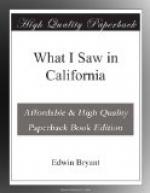JOURNEY FROM ARKANSAS TO CALIFORNIA.
The following general view of the nature of the country which divides the United States from California is taken from a narrative, published by Lieutenant Emory, of a journey from the Arkansas to the newly annexed territory of the United States.
“The country,” says the lieutenant, “from the Arkansas to the Colorado, a distance of over 1200 miles, in its adaptation to agriculture, has peculiarities which must for ever stamp itself upon the population which inhabits it. All North Mexico, embracing New Mexico, Chihuahua, Sonora, and the Californias, as far north as the Sacramento, is, as far as the best information goes, the same in the physical character of its surface, and differs but little in climate and products. In no part of this vast tract can the rains from heaven be relied upon, to any extent, for the cultivation of the soil. The earth is destitute of trees, and in great part also of any vegetation whatever. A few feeble streams flow in different directions from the great mountains, which in many places traverse this region. These streams are separated, sometimes by plains, and sometimes by mountains, without water and without vegetation, and may be called deserts, so far as they perform any useful part in the sustenance of animal life.
“The whole extent of country, except on the margin of streams, is destitute of forest trees. The Apaches, a very numerous race, and the Navajoes, are the chief occupants, but there are many minor bands, who, unlike the Apaches and Navajoes, are not nomadic, but have fixed habitations. Amongst the most remarkable of these are the Soones, most of whom are said to be Albinoes. The latter cultivate the soil, and live in peace with their more numerous and savage neighbours. Departing from the ford of the Colorado in the direction of Sonora, there is a fearful desert to encounter. Alter, a small town, with a Mexican garrison, is the nearest settlement. All accounts concur in representing the journey as one of extreme hardship, and even peril. The distance is not exactly known, but it is variously represented at from four to seven days’ journey. Persons bound for Sonora from California, who do not mind a circuitous route, should ascend the Gila as far as the Pimos village, and thence penetrate the province by way of Tucson. At the ford, the Colorado is 1,500 feet wide, and flows at the rate of a mile and a half per hour. Its greatest depth in the channel, at the ford where we crossed, is four feet. The banks are low, not more than four feet high, and, judging from indications, sometimes, though not frequently, overflowed. Its general appearance at this point is much like that of the Arkansas, with its turbid waters and shifting sand islands.”




